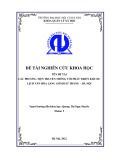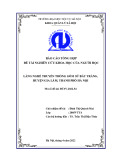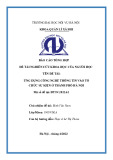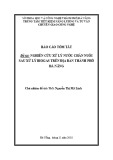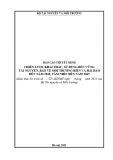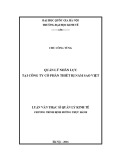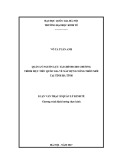
BioMed Central
Page 1 of 15
(page number not for citation purposes)
Cost Effectiveness and Resource
Allocation
Open Access
Research
Setting priorities for the health care sector in Zimbabwe using
cost-effectiveness analysis and estimates of the burden of disease
Kristian Schultz Hansen*1,2 and Glyn Chapman3
Address: 1Institute of Public Health, Department of Health Services Research, University of Aarhus, Vennelyst Boulevard 6, DK-8000, Aarhus C,
Denmark, 2DBL-Institute for Health Research and Development, Jaegersborg Alle 1D, DK-2920, Charlottenlund, Denmark and 3IMMPACT,
University of Aberdeen, 2nd Floor, Foresterhill Lea House, Westburn Road, Aberdeen, AB25 2ZY, UK
Email: Kristian Schultz Hansen* - ksh@soci.au.dk; Glyn Chapman - g.chapman@abdn.ac.uk
* Corresponding author
Abstract
Background: This study aimed at providing information for priority setting in the health care
sector of Zimbabwe as well as assessing the efficiency of resource use. A general approach
proposed by the World Bank involving the estimation of the burden of disease measured in
Disability-Adjusted Life Years (DALYs) and calculation of cost-effectiveness ratios for a large
number of health interventions was followed.
Methods: Costs per DALY for a total of 65 health interventions were estimated. Costing data
were collected through visits to health centres, hospitals and vertical programmes where a
combination of step-down and micro-costing was applied. Effectiveness of health interventions was
estimated based on published information on the efficacy adjusted for factors such as coverage and
compliance.
Results: Very cost-effective interventions were available for the major health problems. Using
estimates of the burden of disease, the present paper developed packages of health interventions
using the estimated cost-effectiveness ratios. These packages could avert a quarter of the burden
of disease at total costs corresponding to one tenth of the public health budget in the financial year
1997/98. In general, the analyses suggested that there was substantial potential for improving the
efficiency of resource use in the public health care sector.
Discussion: The proposed World Bank approach applied to Zimbabwe was extremely data
demanding and required extensive data collection in the field and substantial human resources. The
most important limitation of the study was the scarcity of evidence on effectiveness of health
interventions so that a range of important health interventions could not be included in the cost-
effectiveness analysis. This and other limitations could in principle be overcome if more research
resources were available.
Conclusion: The present study showed that it was feasible to conduct cost-effectiveness analyses
for a large number of health interventions in a developing country like Zimbabwe using a consistent
methodology.
Published: 28 July 2008
Cost Effectiveness and Resource Allocation 2008, 6:14 doi:10.1186/1478-7547-6-14
Received: 14 December 2007
Accepted: 28 July 2008
This article is available from: http://www.resource-allocation.com/content/6/1/14
© 2008 Hansen and Chapman; licensee BioMed Central Ltd.
This is an Open Access article distributed under the terms of the Creative Commons Attribution License (http://creativecommons.org/licenses/by/2.0),
which permits unrestricted use, distribution, and reproduction in any medium, provided the original work is properly cited.







